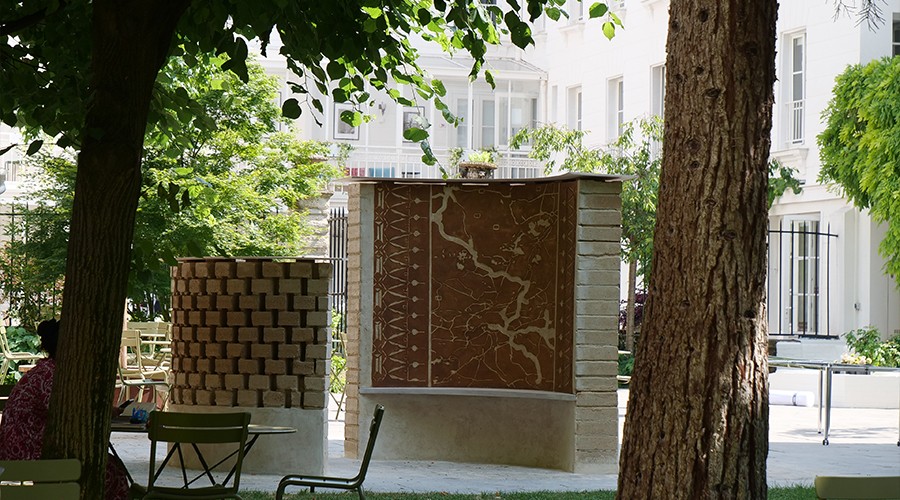Raw Earth Sgraffito Pavilion built at Reid Hall by Columbia Architects

The Raw Earth Sgraffito Pavilion, a construction project led by Columbia professors Lola Ben-Alon and Lynnette Widder, was inaugurated in May 2023 in the Reid Hall garden. An example of sustainable construction practices, the pavilion’s purpose is to familiarize people with the potential of earth construction as a sustainable building practice. The pavilion is a seating space for conversation and sitting in the garden and is decorated along its interior wall by inscriptions that map the different routes taken by the materials used for the structure’s realization.
Lynnette Widder is Professor of Professional Practice at Columbia SPS, as well as Principal and Cofounder of New York architecture studio aardvarchitecture. Lola Ben-Alon is an Assistant Professor at Columbia GSAPP, where she directs the Natural Materials Lab and the Building Tech curriculum. The Natural Materials Lab investigates the earth- and bio-based building materials, their life cycle, supply chains, fabrication techniques, and policy.

Unfired earthen construction has history in every part of the world as a construction method that integrates heritage technique, building longevity, comfort, and low environmental impact. The Raw Earth Sgraffito Pavilion is meant to represent an experimental version of ancient technologies and their relevance to future building practices in an interpretative form.
During its residency in Reid Hall's garden, the Raw Earth Sgraffito Pavilion will evolve. The shapes will transform: corners will round, plaster will abrade, erosion from water and frost will begin to appear, patterns and geometry will change. Time, use, climate: these are all parts of architecture that the Raw Earth Sgraffito Pavilion can make explicit through its patina. It can also invite interventions, passing on authorship to new sets of hands. At the end of its life, the components can be returned, simply by crushing and dissipation, as nutritious compounds to the soil from which they came.
Earth construction, termed “farm to building” by Prof. Ben-Alon, uses natural and readily available building materials that are adapted to the local geo- and bio-physical environments. This shorter supply chain minimizes energy and carbon use through savings in transportation, processing, and intermediate storage, resulting in a more environmentally, socially, and economically viable building product.
The Raw Earth Sgraffito Pavilion uses raw soils and geological products combined with agricultural by-products and living additives for structural integrity. Its walls are constructed of blocks pressed from soil excavated from tunnels dug to expand the Paris RER rapid transit system. The plaster on the interior was purchased from a facility in the Ile-de-France region. The mineral content of the soil creates the pigment of the structure, either pale gray or burgundy. Splintered straw from agricultural by-products is mixed into the clay for the gray base coat. The top coat is enriched with sand and mica to create a finer grain and sheen. The plaster was applied using a meticulous sgraffito technique, which involves the layering and curving of multiple coats to form intricate patterns. The incised patterns reflect the material geographies of the sgraffito technique and the maps framed by those patterns derive from an analysis of trade routes associated with the pavilion's diverse materials.
The construction of the pavilion further fostered knowledge exchange through collaborative activities, bringing together contractors, builders, designers, students, scholars, and material enthusiasts and culminating in discussions of and hands-on engagement with the building techniques. The compressed earth block “body” of the installation was constructed by Les Batisseuses, a social enterprise that engages new immigrants to teach them techniques for building with earthen material. Wood work for the pavilion, including the tricky interface between masonry and timber on the bench and roof, was completed by Patagonia, a team of craftsmen from South America. Students from two Columbia programs at Reid Hall – GSAPP’s Paris New York program and GSAS’s Masters in History and Literature – collaborated on the sgraffito. Their efforts made it possible to transfer and incise the mapped lines in the brief time during which the fresh plaster had the perfect consistency. The plaster was then finished with eight coats of raw flaxseed oil over the course of a ten-day period to improve its longevity.
Collaborators
Lola Ben Alon and Lynnette Widder
Design and production assistance, New York: Zina Berrada
Production assistance, Paris: Prof. Thomas Gardner (Maryland Institute College of Art); Prof. Ariela Katz (ENSA Paris Mallaquais)
Student assistants: Greta Milstein, Vila Shao, Emma Yergat, Kelechi Iheanacho (Paris-New York); David Markey (GSAS); Grace Schleck (Barnard)
GIS/Route mapping: Greg Yetman, Center for International Earth Science Information Network, Columbia
Block production: Cycle Terre
Masonry and plaster: Les Bâtisseuses, led by Eugénie N’diaye
Woodwork: Patagonia
On-site coordination: Krista Faurie